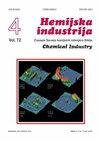Fenton process in dispersed systems for industrial wastewater treatment
IF 0.8
4区 工程技术
Q4 ENGINEERING, CHEMICAL
引用次数: 1
Abstract
Industrial wastewater contains recalcitrant organic compounds with a very complex chemical structure, built of molecules with long chains of carbon atoms and attached different functional groups. Chemical or biological treatments used for removal of these compounds are being replaced with more efficient non-commercial wastewater treatments. Advanced oxidation processes overcome limitations of conventional methods regarding formation of by-products during degradation of recalcitrant organic compounds. The Fenton process, or use of the Fenton?s reagent, has became one of the most utilized processes due to simplicity, economy and accessible amounts of ferrous iron and hydrogen-peroxide, which are used in the process. In specific, the Fenton?s reagent is a catalytic-oxidative mixture of these two components. The ferrous iron Fe2+ initiates and catalyzes decomposition of H2O2, resulting in generation of hydroxyl radicals, which are the main radical species in the process able to detoxify several organic pollutants by oxidation. In addition, other mechanisms besides formation of hydroxyl radicals may occur during the Fenton process and participate in degradation of target pollutants. Generally, the treatment efficiency relies upon the physical and chemical properties of target pollutants and the process operating conditions. The main disadvantage of the Fenton process is production of sludge formed by iron hydroxide at certain pH values. An alternative solution for this problem is application of this process in fluidized bed reactors. This paper presents an overview of Fenton and photo-Fenton processes in dispersed systems for removal of different industrial wastewater pollutants. The most important process parameters, required for efficient degradation of recalcitrant organic compounds are also described, such as the catalyst type, pH value, temperature, H2O2 concentration and retention time. Strict control of Fenton process parameters in fluidized bed reactors at desired values can bring these systems to the commercial use.分散系统中的Fenton法处理工业废水
工业废水含有具有非常复杂化学结构的顽固性有机化合物,这些化合物由带有长链碳原子的分子组成,并连接着不同的官能团。用于去除这些化合物的化学或生物处理正在被更有效的非商业废水处理所取代。高级氧化工艺克服了在降解难降解有机化合物过程中形成副产物的传统方法的局限性。芬顿法,还是芬顿法的使用?S试剂,由于其简单、经济和可获得的亚铁和双氧水用量,已成为应用最广泛的工艺之一。具体来说,芬顿?S试剂是这两种组分的催化氧化混合物。亚铁Fe2+引发并催化H2O2分解,产生羟基自由基,羟基自由基是该过程中主要的自由基种类,能够通过氧化来解毒几种有机污染物。此外,Fenton过程中除了形成羟基自由基外,还可能发生其他机制,参与目标污染物的降解。一般来说,处理效率取决于目标污染物的物理化学性质和工艺操作条件。芬顿法的主要缺点是在一定的pH值下产生由氢氧化铁形成的污泥。解决这一问题的另一种方法是在流化床反应器中应用该工艺。本文介绍了Fenton和光Fenton工艺在分散系统中去除不同工业废水污染物的概述。本文还介绍了有效降解难降解有机化合物所需的最重要的工艺参数,如催化剂类型、pH值、温度、H2O2浓度和保留时间。将流化床反应器中的Fenton工艺参数严格控制在理想值,可以使这些系统投入商业应用。
本文章由计算机程序翻译,如有差异,请以英文原文为准。
求助全文
约1分钟内获得全文
求助全文
来源期刊

Hemijska Industrija
工程技术-工程:化工
CiteScore
1.60
自引率
11.10%
发文量
12
审稿时长
6-12 weeks
期刊介绍:
The Journal Hemijska industrija (abbreviation Hem. Ind.) is publishing papers in the field of Chemical Engineering (Transport phenomena; Process Modeling, Simulation and Optimization; Thermodynamics; Separation Processes; Reactor Engineering; Electrochemical Engineering; Petrochemical Engineering), Biochemical Engineering (Bioreactors; Protein Engineering; Kinetics of Bioprocesses), Engineering of Materials (Polymers; Metal materials; Non-metal materials; Biomaterials), Environmental Engineeringand Applied Chemistry. The journal is published bimonthly by the Association of Chemical Engineers of Serbia (a member of EFCE - European Federation of Chemical Engineering). In addition to professional articles of importance to industry, scientific research papers are published, not only from our country but from all over the world. It also contains topics such as business news, science and technology news, information on new apparatus and equipment, and articles on environmental protection.
 求助内容:
求助内容: 应助结果提醒方式:
应助结果提醒方式:


